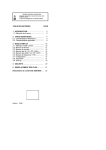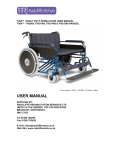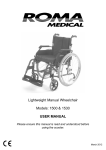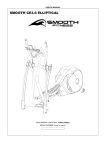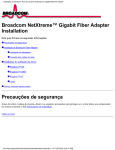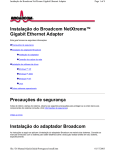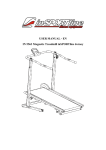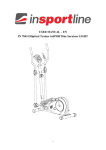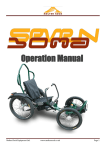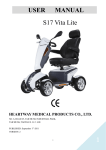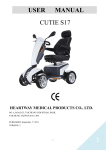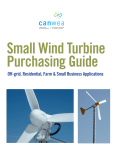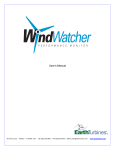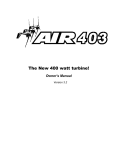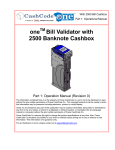Download AWP3.7 Wind Generator Owners Manual
Transcript
AWP3.7 Wind Generator Owners Manual Version 1.1 African Windpower [email protected] www.africanwindpower.com © 2007 African Windpower 2 Contents 1. 2. 3. 4. Safety Warning Introduction Specifications Acquiring the a machine 4.1 Purchasing-Dealer List 4.2 Shipping 4.3 Unpacking the Machine 4.4 List of Equipment Supplied 5. Pre Installation Planning 5.1 Siting the Wind Generator 5.2 Towers and Rigging 5.3 Cables and Controller 5.4 Tools and Equipment Required 6. Assembly Instructions 6.1 Controller Installation 6.2 Wind Turbine Assembly 7. Inspection and Maintenance 8. Fault Finding 9. Drawings and Spare Parts List 10. Warrantee 11. One last thing 2 3 4 4 5 5 6 6 6 7 7 7 8 9 10 13 14 15 16 17 3 Safety Warning ! 1. Electrical Shock hazard The Wind generator can produce higher than nominal voltages when running open circuit. This is especially dangerous with the higher voltage machines which can produce over 500 volts. Keep the output wires shorted initially and carefully follow the installation instructions. 2. The AWP3.7 is a heavily built machine and can cause injury if not assembled and erected carefully, according to the instructions and using the correct equipment. 3. Do not approach the machine while the blades are spinning-they can cause serious injury! Notice African Windpower has made every effort to ensure that the information presented in this manual is accurate but assumes no responsibility for any errors or omissions. Users of this information and AWP products assume full responsibility and risk. 3 4 2. Introduction. This manual contains all necessary information for assembling, operating and maintaining the AWP3.7 Wind generator, in the battery charging configuration, please read it carefully and retain for future reference. The AWP3.7 is ruggedly built, in the style of the ”Heavy Metal School”. The 30 pole machine operates at a relatively low RPM, which together with only 3 moving parts, ensures very long life with little maintenance. The high efficiency blades sweep a large area, ensuring maximum energy capture from low wind speeds other machines ignore. The machine is also suitable for high winds with the simple, upwind side furling gravity return yaw system, protecting the machine by reliably swinging the rotor out of winds faster than 12 m/sec (40 Km/Hr). Other versions of the AWP3.7 can be used for Building Heating, Electric Water Pumping and Inverter Grid Connect. 3. Specifications. Peak Power Rating Rated Wind Speed Start up wind Speed Cut in Wind Speed Energy Production Alternator Design Electrical Output Rotor Diameter Maximum RPM Number of Blades Blade Construction Speed/Power Control Max Design Wind Speed Configuration Corrosion protection Cable Connection Tower Top Mounting Tower Top Weight Controller Dump Load Shipping dimensions 1500 Watts Battery Charging 2000 Watts – Inverter - Grid Connect 12m/s 3.5m/sec 3m/sec 3m/s 4KWHr/Day - 4m/s 7KWHrs/Day – 5m/s 10KWHr/day 30 Pole (Ceramic Magnet) Rotor, Laminated Axial Stator 3 Phase 'Wild' AC, 0-125Hz, 12V,24V,36V,48V,96V,110/220V 3.7 Meters 500 3 GRP Composite design Gravity Yaw System 60m/sec Upwind Rotor – furling tail Epoxy coated / Marine version hot dip galvanised Heavy duty slip rings 3 Inch (80mm NB) Table D Flange - (4 x M16 Bolts on 150mm PCD) 110Kgs (220 Pounds) Turbine Side diversion dump control Wall mounted resistive heater 2000W 150Kgs (308 Pounds) Crate 1900x 570x 540mm (74x23x21ins) Performance Curves (AWP3.6) 12000 Whr 1600 1200 Daily Energy Production 10000 Whr AWP36 Power Curves 8000 Whr 1000 12 V 24 V 36 V 48 V 220 V 800 600 400 200 12 V 6000 Whr 24 V 36 V 4000 Whr 48 V 220 V 2000 Whr 2.0 m/s 3.0 m/s 4.0 m/s 5.0 m/s 6.0 m/s 7.0 m/s 5 mph 7 mph 9 mph 11 mph 14 mph 16 mph 13 Wind Speed (M/s) 11 9 7 5 3 0 1 Power O/P (W) 1400 Mean windspeed 4 5 . 4. Acquiring a Machine It is recommended that you purchase an AWP Wind Turbine from a dealer in your country if possible. This should reduce your delivery time and cost, and improve the back up service available to you. 4.1 List of Dealers World Wide Australia Australian Windpower Perth Canada France Krug SARL Greece Kenya Uganda Tanzania Namibia Digital Communications Nairobi HPS Engineering New Zealand South Africa South Africa UK Otto Solar Uppington Jacobs Electrical Carnarvon Scoraig Wind Electric Scoraig Scotland USA If this is not possible then African Windpower can supply you directly from Johannesburg South Africa by Sea or Air or put you in touch with your nearest dealer. Contact : Oloff Smyth [email protected] +27 84 4444118 5 6 4.2 Shipping Crate Dimensions A complete AWP.3.7 with Controller and Dump Load is packed into a wooden crate 1950mm x 550mm x 550mm (74”x 24”x 24”) weighing 145Kgs (250Pounds). 4.3 Unpacking the Crate The crate lid is secured with 6 posi-drive screws marked by red circles. After removing the blades and tail booms, the two blocking braces should be removed by unscrewing 4 posi drive screws on the sides of the crate also marked by red circles. 4.4 List of Equipment Supplied QTY 1 1 1 1 1 3 1 1 1 1 3 4 7 2 1 2 1 3 6 3 3 3 1 1 DESCRIPTION ALTERNATOR (OF CHOSEN VOLTAGE) YAW HEAD EQUIPED WITH SLIP RINGS AND TAIL HINGE PIN FITTED TAIL BOOM FRONT SECTION TAIL BOOM REAR SECTION TAIL FIN SET BLADES –( BALANCED SET) NOSE CONE CONTROLLER DUMP LOAD FITTINGS KIT CONTAINING THE FOLLOWING : ALTERNATOR MOUNTING BOLTS M16 X 30MM , STAR WASHERS YAW HEAD MOUNTING BOLTS M16 X 50 , NYLOCK NUTS, WASHERS TAIL FIN BOLTS M8 X 60MM , NYLOCK NUTS AND WASHERS TAIL BOOM CLAMP BOLTS M8X 100MM, NYLOCK NUTS , WASHERS TOP CAP TOP CAP BOLTS M6X 15, WASHERS CABLE SUPPORT THIMBOLE, M8 BOLT, NYLOCK NUT, 40MM WASHER NOSE CONE BOLTS M6 X 30MM, WASHERS BLADE BOLTS M12 , NYLOCK NUTS, WASHERS BLADE CLAMPING PLATE BLADE CLAMPING PAD NOSE CONE MOUNTING BRACKET TOWER TOP FLANGE AND 4 GUSSETTS USER MANUAL 6 7 5 Pre Installation Planning 5.2 Siting The Wind Turbine Smooth, laminar airflow 2H Turbulent airflow H 2H 20 H Turbulent airflow created by obstructions (Ad. P.Gipe, 93) To ensure good performance from the Wind Generator it is important that care is taken in the siting of the machine. Buildings, trees and rocky outcrops etc disrupt the smooth flow of wind creating a wind shear with the wind velocity nearer the ground being slower than higher up. Turbulence is also created by these obstructions. Turbulence is detrimental as the swirling air causes the Turbine to continuously yaw increasing stress and wear and tear on components and reducing the useful life of the equipment. Therefor, as a general rule the Turbine should be mounted twice as high as any such obstructions. The power obtained from the wind is proportional the cube of the wind speed, and the wind speed increases with height from the ground. A 26% increase in wind speed from a higher tower will yield a 100% increase in power from the turbine. A little more money spent on a higher tower will harvest the same power as 2 machines! Preference should be given to the prevailing wind direction but it should be noted that tall features behind the Turbine can also slow down the wind flow through the turbine. 5.3 Tower and Rigging Great care should be taken in the selection and preparation of the wind turbine tower as this is the most difficult and crucial aspect of the entire installation. Towers can be the triangulated self supporting type used with traditional wind rose water pumps however they are normally about 8 meters high with surrounding established trees out growing them. Greater heights can only economically be achieved with guyed towers. They can be tubular tilt up or fixed lattice types. Tilt up towers permit assembly and maintenance on the ground while latticed towers make climbing easier and safer. In all cases it is imperative that the turbine should be mounted on a 90mm pipe extending at least 1700mm from the last flange to which the guys or structure is attached. There should be a minimum of 300mm measured horizontally from the lowest tip of the blade to any part of the tower. Many blades have had their tips shattered when this has not been observed. A separate manual covering towers in detail is available. 7 8 5.4 Cables, Controller and Battery Bank The table below indicates the correct cable size for various cable runs. Machine 12 Volt 24 Volt 36 Volt 48 Volt 110 Volt 220 Volt 20 Meters 10mm 10mm 6mm 6mm 4mm 2.5mm 50 Metres 16mm 10mm 10mm 6mm 4mm 2.5mm 100 Meters 25mm 16mm 16mm 10mm 6mm 4mm 200 Meters 35mm 25mm 25mm 16mm 10mm 4mm 5.5 Tools required. 1 1 1 1 1 1 1 1 1 1 1 1 1 1 10MM COMBINATION SPANNER OR SOCKET 13MM COMBINATION SPANNER AND SOCKET 17MM SPANNER 19MM COMBINATION SPANNER OR SOCKET 24MM COMBINATION SPANNER AND SOCKET SOCKET DRIVER SHIFTING SPANNER/ADJUSTABLE WRENCH 250MM/12INCH SCREW DRIVER SIDE CUTTERS CRIMPING TOOL SMALL HAMMER TEST METER DRILLING MACHINE AND 9MM DRILL BIT LOCKTITE 5.6 Other Items Required Insulation Tape FlexibleDrop Cable and Lugs to suit Armoured 3 core cable or house wire and conduit Batteries, Clamps and Battery cable Charger Fuse Main Battery Fuse Inverter and AC Wiring 8 9 6 Assembly Instructions • Install the Controller, Dump Load, Battery, Fuses and Cables first so that you can control the Turbine when the tower is lifted, in a safe and orderly manner. • It is best to assemble the machine while on the ground, onto a lowered tilt-up tower, which can then be raised. Due to the considerable weight of the generator (125 kg), it is difficult and dangerous to attach it to a tower already erected. • Before assembling the turbine to the tower top, the tower should be first be assembled and raised, all rigging should be adjusted to ensure that the tower is straight and vertical, so that the tower can de raised and lowered with out problems • Although one person can assemble the machine with mechanical aids, it is advisable to have an assistant since many parts are heavy and cumbersome to manoeuvre into position. At least two people are needed to raise the machine. • Keep the alternator wrapped in the plastic sheeting as long as possible to prevent dirt or metal objects from entering the alternator and becoming lodged between the magnets and the rotor. • Check that all components as listed are present. Open the yaw head inspection door and check the slip ring brushes are running true and all the connections are tight. 6.1 Charge Controller and Dump Load The charge controller supplied by AWP contains a three phase rectifier, a DC meter, a Dump Load Controller, and a Turbine Brake Switch. The terminals are marked as shown below. The three cables from the alternator connect to the Brass screw terminals marked L1, L2 and L3. The Battery and Dump Load must be connected to the Marked Terminals using 6mm lugs .Take care not to reverse the Battery Cables as this WILL damage the rectifier diodes. The controller should be located near the batteries in a well ventilated, dry room. The battery should be protected by fuses to the controller and the load (inverter etc). Do not use only one fuse as the inverter could be left connected directly to the wind turbine in the event of the fuse blowing and could be damaged if the dump load circuit was not connected or functioning correctly. 9 10 Make sure that the cables from the controller to the battery and the dump load are both rated for the full output current of the turbine. Make sure the links and connections in the Dump Load are correct for the voltage of the system, and And are all tight. CAUTION : Before removing the short on the alternator wires make sure all the controller connections are correct and secure. ( If you allow the turbine to run and feed power to the controller with no battery or dump load connected, the resulting high voltages will destroy the PWM circuit and possibly the rectifiers. Dump Load and Controller Open Controller 10 11 Controller Schematic Diagram Inter Connections 11 12 Wind Turbine Assembly Procedure : Slip Ring Version Yaw Head a. The top of the lowered tower should be supported about 1,5 meters off the ground. (1) b. Drill a 9mm hole through the tower pipe 60mm from the top flange(2). c. Pull the drop cable through the tower with fence wire or something suitable, make a loop 300mm from the end, place it over the thimble and secure with cable ties (3). 1 2 3 d. Attach the yaw head to the top flange loosely with one of the M16 x 50 bolts (3) e. Connect the three cables from the slip rings in the yaw head to the three drop wires using split nuts, crimped ferrules or crimped lugs bolted together. Take great care to insulate the connections with a large amount of insulation tape to prevent wear through due to vibrations (4). f. Through the drilled hole, bolt the thimbol to the internal side wall of the tower pipe making sure the large flat washer is on the inner side of the thimbol (3) g. Push the joined cables into the tower and secure the yaw head with the remaining bolts (4). h. Swing the yaw head up into position and tighten the 4 x M16 x 50mm bolts(5) i. Fit and secure the top cap with the two M6 x 15mm bolts (6). 4 5 6 12 13 Alternator j. The alternator weighs about 75 Kgs and is very awkward to hold, so plan this carefully. The tail gate of a pick up works well, or you could use a wheel barrow or drum etc. (7) k. Line up the bolt holes and pass the cables through the correct hole provided. Take care not to crush the cable while doing this and tighten the 24mm bolts with lock washers after first putting some lock tight on the threads (8) l. Screw one blade stud (short threaded end) into one hole in the front of the alternator. Ensure the leads are not touching each other or parts of the yaw head. Use the blade bolt to turn the alternator – it should turn freely. Short the three leads together and turn again It should be difficult to turn (9). m. Bolt the other 5 blade bolts into place (short threads into alternator) (9). 7 8 9 Tail n. Remove the tail hinge pin and attach the front tail boom section (10). Tighten the tail hinge pin nut so that the bolt is tight against the lugs and can not turn (11).. o. Attach the rear tail boom section the front section using the two angle clamps and M8 x 100mm bolts. p. Attach the tail fins to the rear tail boom section with M8 x 60 bolts and make sure the two M5 anti rattle bolts are fitted to the top and bottom of the tail fin (12). 10 11 12 13 14 Blades q. Mount the blades onto the blade bolts with the flatter side facing away from the alternator(13) r. Fit the flexible blade clamping pads onto the blade bolts directly over each blade, followed by the blade clamping plates, then fit the nose cone brackets to the blade bolts between the blades, with the threaded tabs facing away from the alternator face. Fit the washers and M12 nylock nuts to the blade bolts and tighten the nuts on one blade to 10 N-m of torque (14) and lightly tighten the other two blades. s. Measure the tip to tip spacing to ensure that they are with in 5mm of each other. If not, adjust the spacing by holding the tightened blade and bump the other two by hand (16). When correct tighten all the nuts to 20 N-m (15 ft lbs) of torque. t. Fit nose cone and bolt on with M6 x 30mm bolts and washers (15). 13 14 15 u. Check that the rotor can turn freely and that te blades pass by the tower at equal distances,. If there is more than 15mm difference loosen the blade bolts and fit small shims of thin plastic (such as pieces of plastic bottles)between the blade and generator. v. Connect the cables from the alternator to the slip ring terminals and make sure all is in order in the terminal box. Close the door and screw down the locking screw. Connect all the cables through to the controller. Make sure everything is connected up in the controller including the battery, to prevent damage when the turbine runs. Place the brake switch in the Stop position. w. Check that the rotor has resistance to turning resistance to turning the rotor. x. Raise the tower and secure guy cables. y. Switch the Brake switch to run. If there is sufficient wind the turbine will start turning and the ammeter will show the amperage flowing into the battery. Check that Dumping occurs when the reccomended Battery Float Voltage is reached. z. Check that there is no vibration or untoward noises coming from the turbine. Secure all rigging on the tower. 14 15 8. Inspection and Maintenance a. Wind Turbine- The turbine has been designed to operate with a minimum of maintenance. • Every 6 months check excessive twisting of the electrical cables inside the tower and if necessary disconnect at tower base and untwist (Non Slip Ring Versions). Listen for unusual alternator or blade noise and look for excessive vibration which would all call for close inspection. • Inspect the blades for leading edge ware and apply grease to all lubricating points. This should be done either by lowering the tower or by climbing it. b. Tower Every 6 months • Check that the guys are tight. Check that the guy cable clamps are tight by ensuring that there is still a slack loop between the upper most clamp and the next lower one. • Check that the shackles are tight. • Check that the stay rod bolts are still locked together. • Check all cables for excess fraying or rust. Every 12 months • Check the upper guy joints for wear and rust • Paint all exposed metal parts. 9. Fault Finding Symptoms Turbine Fails to Turn in good wind Turbine turns slowly in good wind Turbine growls and amps are low Low output batteries flat Turbine vibrates excessively Turbine fails to swing into the wind Turbine running at high speed no output Possible Causes Shorted cables Shorted diodes Failed bearings Foreign body in generator Partial short in cables 1 diode short 1 phase open circuit Faulty diodes Insufficient wind High power usage Blades out of balance Yaw bearing worn Tower top not vertical Yaw bearing worn/ broken Cables disconnected Battery Fuse blown Controller Ammeter open circuit 15 Solutions Remove short Replace faulty diode(s) Replace Remove obstruction Remove short Replace diode Repair open circuit Replace diodes Improve tower siting/height Economise on power use Check blade geometry/balance Replace yaw bearing Adjust guy cables Replace yaw bearing Fix cables Replace fuse Replace meter 16 10. Exploded View and Parts List (AWP3.6) 16 17 11. Warrantee African Windpower Warrantee Wind generators, controllers, and associated equipment manufactured by African Windpower and distributed by Distributor are warranted against defects in design, material, and workmanship for normal use for which intended. The warranty period extends one year from installation or two years from the date of purchase by the user, whichever comes first. During the warranty period AWP will repair or replace, at its option, defective components and assemblies. In __COUNTRY__ warranty service for AWP is provided by Distributor. Customers should ship defective components and assemblies to Distributor at their own expense for repair or replacement. Return shipping will be provided. Please call Distributor and make arrangements before shipping. This limited warranty does not cover the following: Towers, equipment, materials, or supplies not manufactured by AWP. AWP equipment that has been improperly installed or modified without approval from AWP or Distributor Damage or loss from winds in excess of 45 m/s (100 mph) Lightning damage or other acts of God. Incidental or consequential damages. AWP reserves the right to make design changes, improvements, or additions to its products without obligation to install such changes or improvements in existing products. This warranty may be extended to five years by the purchase of an extended warranty. The extended warranty shall have the same terms and conditions, except it shall be in force for 5 years from the date of installation. 17 18 12. One last thing Try not to get friends like this to help… 18


















